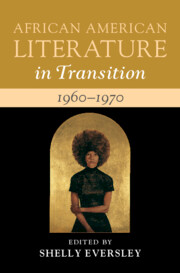Book contents
- African American Literature in Transition, 1960–1970
- African American Literature In Transition
- African American Literature in Transition, 1960–1970
- Copyright page
- Contents
- Contributors
- Preface
- Acknowledgments
- Chronology
- Introduction
- I Poetry and Music
- Chapter 1 The Society of Umbra and the Coming of the Black Aesthetic
- Chapter 2 Robert Hayden, the Black Arts Movement, and the Politics of Aesthetic Distance
- Chapter 3 Breathing
- Chapter 4 Reconsidering “the Revolution in Music”
- II Culture and Politics
- III Beyond the Canon
- Index
- References
Chapter 2 - Robert Hayden, the Black Arts Movement, and the Politics of Aesthetic Distance
from I - Poetry and Music
Published online by Cambridge University Press: 10 November 2022
- African American Literature in Transition, 1960–1970
- African American Literature In Transition
- African American Literature in Transition, 1960–1970
- Copyright page
- Contents
- Contributors
- Preface
- Acknowledgments
- Chronology
- Introduction
- I Poetry and Music
- Chapter 1 The Society of Umbra and the Coming of the Black Aesthetic
- Chapter 2 Robert Hayden, the Black Arts Movement, and the Politics of Aesthetic Distance
- Chapter 3 Breathing
- Chapter 4 Reconsidering “the Revolution in Music”
- II Culture and Politics
- III Beyond the Canon
- Index
- References
Summary
Ready-made histories of 1960s cultural development might easily overlook Robert Hayden. His apparently genteel politics, reflected in commitments to racial cosmopolitanism and substantial reverence for the Western canon, distinguished him from many of the innovators and experimentalists of 1960s Black radical poetry. However, Hayden’s distinctive contributions to the decade played a key role in the evolution of African American poetics. His political aesthetic became an important model for successful Black poets of the later twentieth century. These academic poets, whose professional and intellectual lives were distanced from the economic and cultural exigencies of the Black majority, learned much from Hayden’s theory of aesthetic distance. While a powerful Black aesthetic of the 1960s called for art that appeared to spring from the heart of the Black folk masses, Hayden honed a deeply introspective Black poetics, which contemplated the experiential distance that stretched between the “colleged” poet-speaker and the Black folk world.
- Type
- Chapter
- Information
- African American Literature in Transition, 1960–1970Black Art, Politics, and Aesthetics, pp. 50 - 73Publisher: Cambridge University PressPrint publication year: 2022



